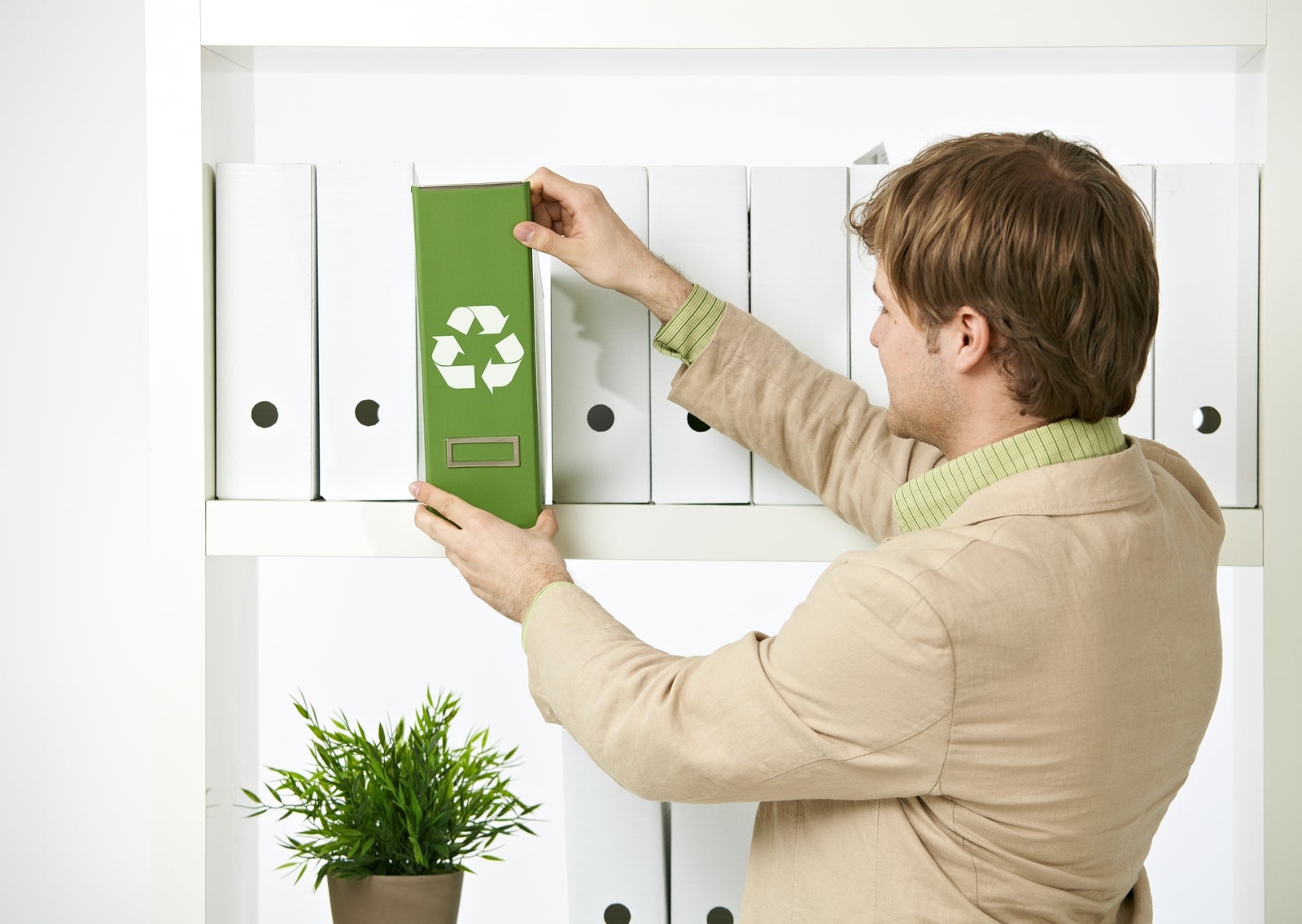16 Pros Share Their Top Eco-Friendly Office Tips
By: Angela Ash

A recent study shows that over 58% of offices in both the U.S. and Canada have made noticeable strides toward sustainability. In other words, this is definitely not a passing trend.
More people are seeing that being as eco-friendly as possible is a responsibility that everyone should take on, regardless of their age, profession or culture. The fact is that there is always SOMETHING that each person can do to make our world a better place for both current and future generations. Every little bit DOES count!
While it’s common to begin your sustainability efforts at home, that doesn’t mean that’s where they need to end. Actually, it’s not unusual for people to carry over their ideas and habits into the office, wherever that may be.
With so many remote and hybrid workers, the idea of the “office” has definitely become more relative. It can be a cubicle in a large corporation, a desk at your brand-new startup, a corner of your living room, or your favorite park bench at your second destination on a five-stop travel plan.
What matters is that you take sustainability with you wherever you go! So, let’s take a look at some of the top ways 16 professionals are making the world a more eco-friendly place… one workspace at a time.
1. Compost Your Shredded Paper
Compost your shredded paper. You may be surprised to hear that you can purchase and use a compost bin designed for indoor use. You won’t need to worry about unpleasant odors if you maintain your compost bin properly.
“The secret to odor-free composting,” according to Deborah Goldberg, a sustainability expert from Clearsurance, “Is having a 50/50 balance of green and brown materials. Shredded paper is an example of brown material, while vegetable and fruit scraps are examples of green materials.
If your office has outdoor space, you can use an outdoor compost bin, and you won’t have to maintain the ideal balance quite so carefully, although, for best results, you should still try for an equal mix of brown and green materials.”
2. Come Up With Sustainability Projects for the Entire Team
Sustainability projects may raise awareness while also improving employee morale and teamwork in the office. Starting or permitting a more effective recycling process, as well as assisting with the purchase of energy-efficient equipment and sustainable cleaning materials, might be among the initiatives.
“Furthermore,” Imani Francies of Us Insurance Agents adds, “Team projects may be a fascinating way to combine competition with environmental awareness. You might, for instance, encourage the workplace to spend a month without using any plastic dining cutlery and praise those that keep to it with modest treats like gift cards or goodies.”
3. Use Electronic Signature Services
Of course, we all know that avoiding paper usage as much as possible is always a good thing. But, what about those documents requiting signatures?
“My company has completely got rid of paper documents because we knew it’s not only a waste of money but also a waste of natural resources,” says Marilyn Gaskell of TruePeopleSearch. “Instead of signing documents with paper, we are now using electronic signature services. Also, we have dumped our printers and fax machines, and currently, everything is stored on the cloud and transmitted via digital platforms. We benefit a great deal from digital transformation.”
4. Use Automatic Motion-Activated Light Switches
When it comes to ways to reduce consumption and impact on the Earth, finding ways to curb electricity consumption can often be a great way to reduce the negative impact on the environment. After all, the energy that is used to light up our homes and offices usually comes from the use of fossil fuels, which create high levels of carbon dioxide emissions.
But Eden Cheng of PeopleFinderFree adds, “In an attempt to help combat this, we recently installed motion-activated light switches in our break rooms, conference rooms, storage spaces, and other less frequently used rooms which have helped us to significantly eliminate the possibility of the lights being accidentally left on. This, in turn, has not only helped us to save money on our utility bills but most importantly, has also helped us to reduce our impact on the environment in the process.”
5. Do an Energy Audit
Imagine trying to take a 2,000-mile trip with no map and no GPS. That’s what it’s like when you try to make your company sustainable without first understanding your energy usage.
Kelly Bedrich, founder of ElectricityPlans notes, “An energy audit includes inspections of lighting, air conditioning, heating and ventilation equipment, controls, refrigeration, air compressors and water consuming equipment. It includes anything that uses energy, from the coffee pot to the lights in your elevator. This can be done with a DIY ‘walking around’ checklist, or it could be an engineering study. Whichever route you go, this gives your company a baseline of what you have and identifies where you can make improvements.
6. Implement the Use of Cloud Communications
Cloud communications, by enabling remote work, have reduced the negative environmental impacts of businesses.
According to Luke Genoyer of United World Telecom, “Cloud communications can reduce a company’s carbon footprint by eliminating workers’ daily commutes, work-related travel, and physical office buildings + construction. Most of their work, including phone calls and chat, can be done online.”
7. Minimize Traditional Energy Consumption
Reducing your energy consumption at the office can help your business become more sustainable.
“First,” notes Harriet Chan of CocoFinder, “You need to ensure that all your light bulbs are LED fixtures. Additionally, many alternative energy sources can power your office. For example, you can utilize geothermal, wind or solar power. The best thing is that green power sources are readily available and you can always contact them for their services. Their prices are also affordable, which will help you reduce operational costs while saving the environment.”
8. Remove Space Heaters
Most offices are set at 72 degrees in the summer and 68degrees in the winter. And the HVAC seldom cools uniformly across the office. That leads to some people using space heaters.
But according to Rebecca Bridges of ElectricityPlans, that may not be the best idea. “A single 1500 watt space heater running 8 hours a day, 5 days a week can add almost 250 kWh to your electricity bill. Multiply that out by the number of employees and it adds up. Instead, remove space heaters, get your HVAC system balanced and pick a more moderate temperature setting. Or, you can move those people who are cold closer to the window, for natural sunlight and warmth. You’ll lower your electricity bill, helping to reduce carbon emissions in your area.”
9. Make Small Everyday Changes
Making an office space more sustainable doesn’t have to be complicated!
As James Burati of 1-800-PackRat muses, “Employees can choose to make small changes throughout their day-to-day, like printing double-sided documents, recycling paper to use as scrap paper, or even switching to reusable kitchen items. As more individuals opt for more sustainable options in the workplace, it’ll lead to an overall big improvement for the office’s sustainability!”
10. Use “Green” Cleaning Products
Have you ever thought about how achieving a more sustainable workspace can save money and help the environment?
Adrian Pereira of Eco Pea Co. notes, “Consider using nontoxic and biodegradable cleaning products for your kitchen and desk areas. This easily-implementable step can encourage your business and employees to act more sustainably. Greening your office with simple initiatives like this can lead to more impactful sustainability efforts that can make a significant difference. Pursuing earth-friendly tactics in the office can truly help your business and the environment for the better.
11. Look at How You Handle Waste
Sustainability is quickly becoming a greater concern to the world at large, and the office is no different. Even making small steps can have a big impact on reducing wastefulness in the office.
For example, Sacha Ferrandi of Source Capital says, “Removing individual trash cans in favor of a larger communal trash can and recycling bin encourages more thoughtful consideration of what to throw away. Having to make more of an effort to throw waste away can also lead to workers recycling more often. Individual trash cans lead to thoughtlessly tossing everything away as waste even when it could have been reused or recycled, and eliminating them is a fantastic step towards a greener office.”
12. Create a Dedicated Sustainability Team
Often, it’ll take more than just individual effort to make the office more sustainable. Creating a dedicated sustainability team for your office is good for multiple reasons; it makes it easier to achieve more, while also increasing awareness of sustainability across the office.
To get some ideas, Chris Hunter of ServiceTitan suggests, “The sustainability team can do things such as convincing the office to purchase more eco-friendly equipment, set up recycling programs, and do weekly or monthly check-ups on how sustainable the working space is. Having a group that can discuss these things between them and comes to real, powerful decisions is a much better way to encourage sustainability than an email from a high-ranking employee.”
13. Go With Paperless Billing
One small way to make a big impact toward creating a sustainable office is to switch to online/paperless billing! Whether it be utility payments, customer invoices, or anything in between, paperless billing is almost always an option.
“Many people prefer to pay bills online, so it likely won’t be a huge change,” adds Sanem Ahearn of Colorescience. “And you can always leave the option to deny paperless billing for the more traditional customers. Of course, in many areas of business, you may still choose to use paper as a backup to your online storage, for meetings, or for overall organization, but there are still small ways to decrease your carbon footprint.”
14. Challenge Each Other
Even if you already have a sustainability team, it’ll be far more successful if you make it fun. Don’t just create projects, but how about challenges?
“Bringing sustainability into the office doesn’t happen overnight,” mentions Megan Jones of NutraSweet Natural. “This is why it’s important to be consistent with the positive changes you make in the office. Think of challenges such as going a month using windows as lighting instead of a lamp on their desk. This would not only create sustainability throughout the office but allow employees to bond as well. At the end of the month, teams could get rewarded with fun prizes.”
15. Think About Transportation Options
Have you ever considered encouraging employees to find eco-friendly ways to get to work? Well, a great way to reduce carbon emissions is through carpooling.
“Employees in the same neighborhoods can begin a carpool group,” explains Andrew Grant of Dutch, “Which can slash the amount of greenhouse gas being emitted through commuting to work! If employees live close enough to work to walk or ride their bikes to the office, even better! Utilizing public transit can also make a big difference in reducing pollution as well. Lastly, if your office can instate a work-from-home day once or twice a month, you can really cut down on your company’s carbon footprint!
16. Get Into the “Green” Mindset
Making major changes for sustainability means that you will need to actually make life changes.
According to Scott Hogan of SaltWrap, “Too often, people may jump on the bandwagon when it comes to many things, such as going green, staying healthy and much more. That’s why you actually have to begin to look at things differently, constantly searching for ways to do your part and stick to the changes that you’ve implemented — both at home and the office.”
3140 Views













